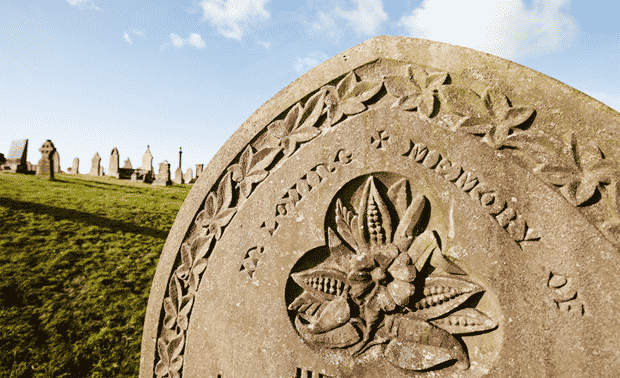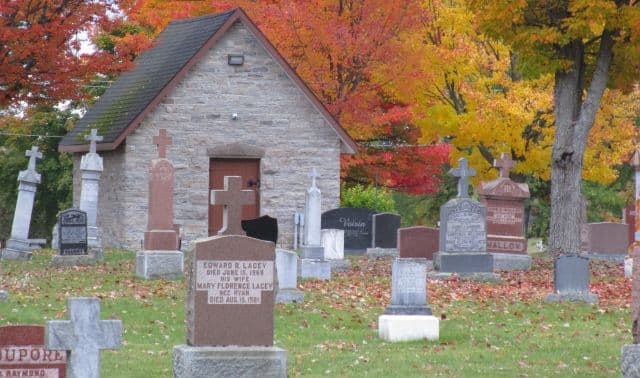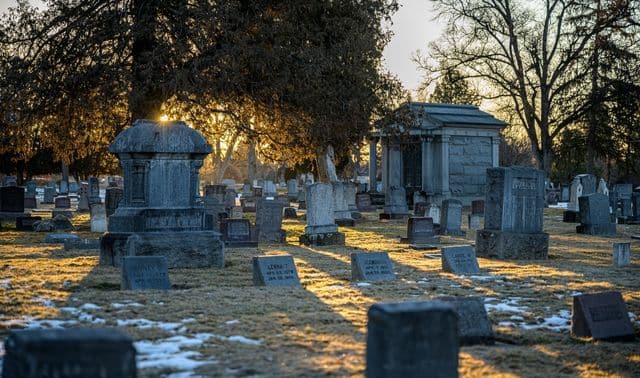Sign up for the Family Tree Newsletter! Plus, you’ll receive our 10 Essential Genealogy Research Forms PDF as a special thank you.
Get Your Free Genealogy Forms
"*" indicates required fields

It’s been said that dead men tell no tales. But as genealogists know, their tombstones do. A headstone can tell you names, birth and death dates, cause of death, family relationships, nicknames, religious and professional affiliations, hobbies and details of military service. The symbolic images on gravestones even give insight into our ancestors’ feelings about death.
The graveyard itself has its own story to share. A cemetery’s stones, burial plots, layout, landscape and location speak volumes about the lives of the individuals buried there.
So how do you decode these family history details from the cemetery? By asking the right questions. Going beyond just “What’s on the tombstone?” will help you uncover hidden details about your relatives’ lives.
ADVERTISEMENT
1. What are the different types of cemeteries?
From a 17th-century churchyard to a half-concealed family plot on a former plantation, the type of resting place is your first clue about the society your ancestors lived in and their feelings about life and death. These types of cemeteries are common in the United States:
Churchyard cemeteries
Europeans brought their burial practices with them to America. According to Marilyn Yalom, author of The American Resting Place: 400 Years of History Through Our Cemeteries and Burial Grounds (Houghton Mifflin), the settlers’ first cemetery in America was a Jamestown, Va., churchyard. Churchyard burials were especially common in the South, as were family burial sites on plantations, farms and even small properties.
Because Puritans, who largely settled in New England, sought to separate themselves from Anglicans and Catholics, they didn’t want their dead associated with churches.
ADVERTISEMENT
“Puritan graveyards were … somber places intended to convey the twin truths of inevitable human decay and ultimate confrontation with one’s Maker,” Yalom says. “Their burial grounds were on separate plots in austere places, with slate stabs with little more than the person’s name and place of death.”
It wasn’t just Puritan cemeteries that were dismal. Colonial burying grounds reflected the sad fact that death came too soon for too many in this untamed wilderness—and the living couldn’t waste precious resources on tending graves. No lush landscaping softened the rows of stones. Grave markers were simple slabs carved with less-than-comforting epitaphs and frightening images, such as skulls.
Family cemeteries
Entire burial grounds belonging to a single family are most common in the South, where rural settlement patterns made it difficult to establish common cemeteries outside cities. But there are more than 3,000 family burial grounds in Rhode Island alone.
The types of markers found in family grounds varies from simple unmarked stones or trees to carved monuments. During the 1800s, local and state laws began prohibiting human burial on private property, and small, family cemeteries became rarer (though family plots at public cemeteries are still common). Today, many have all but disappeared into the surrounding landscape. Sometimes local history buffs know where these are. It’s worth asking around.
Garden cemeteries
In fewer than 200 years of settlement, urban American graveyards became as overcrowded as city streets. During the 19th century, city leaders began building or relocating burial grounds outside city limits for space and public health. At the same time, beliefs about death became more optimistic. Romantic thinkers described death as a natural rest; religious leaders promoted the idea of universal salvation. The new cemeteries on the outskirts of towns reflected their views with pleasant, parklike settings.
“The cemetery focuses now on beautiful trees and flowers, grass and even beautiful sculpture,” Yalom says. “It’s a place for the dead to sleep and of comfort for the living.”
The first full-blown American garden cemetery was Mount Auburn in Cambridge, Mass., in 1831. Appropriately enough, the Massachusetts Horticultural Society led the effort to design the tree-shaded, pond-dotted landscaping.
Military cemeteries
Amid the gradual changes in community burial grounds, another type of graveyard emerged in the 19th century: the military cemetery. Today, more than 3 million American soldiers and their families are buried in military cemeteries at home and abroad.
Before the Civil War, most soldiers-at-war were interred where they fell. But then young men began dying by the thousands in battles such as Antietam, Bull Run and Gettysburg. The dire need to quickly bury those who died in the war led to the creation of 14 national military cemeteries in 1862. The first grave markers were made of wood, but they weathered in the elements, and so in the 1870s, marble headstones replaced wooden ones.
Since then, more American military cemeteries have been established around the country; you can learn more about those under Department of Veterans’ Affairs online. States have created military cemeteries as well. Abroad, the American Battle Monuments Commission (ABMC) maintains 24 cemeteries for US soldiers who died in battles overseas. These graveyards are some of the most visited burial places, and their graves are among the most decorated.
An ancestor’s military burial can tell you a lot about him. The headstone may carry one of nearly 40 religious or cultural symbols, such as a cross or Star of David (see symbols that may appear on military headstones). A spouse might be buried alongside a veteran. You may learn the deceased’s military branch, rank and reserve unit where applicable, which can lead you to draft records, muster rolls and pension applications, among other military records.
Finding a grave in a military cemetery can be as easy as searching online. The Department of Veterans’ Affairs online Nationwide Gravesite Locator includes national, state and other military cemeteries, as well as some veterans’ burials after 1997 in private cemeteries. Search the ABMC databases for soldiers buried abroad. Interment.net’s National Cemeteries indexes offer searchability by name or alphabetically within cemeteries.
Memorial parks
A third development in American cemeteries, aimed to further distance the morbid association of death, occurred at the beginning of the 20th century. In her book, Yalom says you can tell a memorial park by the flat granite and bronze markers set flush with the ground, as well as its beautifully landscaped grounds.
The differences from the garden cemetery are subtle but important. Grave markers are easier to mow over, but less capable of expressing personal messages. Wide expanses of lawn, chapels and large sculptures may attract multitudes who barely notice they’re in a burial ground.
The modern sensibility of a memorial park echoes the increased efficiency, order and greater social conformity of 20th-century American life. Death has become even further removed from the every day: Professionals care for the dying and deceased, life expectancy has risen, and the gentler “passed away” commonly substitutes for “died.”
2. How is the cemetery organized?
Many American neighborhoods have strong group identities, and so do our graveyards. Our ancestors often were buried in groupings by ethnicity, race, religion or family.
Ethnicity and race
Before the Civil War, slaves were usually buried in unmarked graves. In cities, Yalom says, the poor and those of African descent often ended up in inferior cemeteries. The African Burying Ground, discovered in 1991 in Lower Manhattan, contained up to 20,000 occupants, stacked vertically, with few permanent markers (the African Burying Ground site is now a monument; learn more online).
“It wasn’t until the 1950s that the law made it illegal to refuse African-American burials in interdenominational cemeteries,” Yalom says. “There was definitely segregation between blacks and whites [in cemeteries].” Other groups were affected, too. A tour of US cemeteries would reveal evidence of separate burial places for groups including Chinese, Armenian, Jewish, Scandinavian, Alaskan and Hawaiian natives.
Ethnic groups sometimes self-segregated when burying their dead. In Rest in Peace: A History of American Cemeteries (21st Century Books), author Meg Greene describes practices of European immigrants to the Midwest. “Wherever possible, immigrants established their own cemeteries. Immigrant cemeteries reflected the cemeteries in the country of origin—whether it was in Czechoslovakia, Poland, Russia, Greece or Italy. The cemeteries helped immigrants hold onto some of their cultural traditions.”
Many still choose burial in an ethnic cemetery or section, particularly recent Latin American, Asian and Middle Eastern immigrants who maintain a strong group identity. Next time you visit a cemetery, watch for surnames of a common ethnic origin, inscriptions in foreign languages and other evidence of strong ethnic identity. You may find your ancestor buried among a large kinship network from the old world.
Religion
Many of the United States’ earliest burial grounds were reserved for members of a faith, such as Catholics, Anglicans, Jews, Baptists and Quakers. Although some may view this as religious elitism, people often simply chose to be buried among fellow believers.
If your ancestor was buried in a churchyard cemetery, chances are pretty good he or she was a member of that faith. Check with the church office for old membership records as well as cemetery records, and take note of the exact location. Catholics, Anglicans and some Protestants coveted burial under the church floor itself or at least close to the church walls—the nearer the altar, the better. But don’t despair of your ancestor’s piety or social standing if she’s nowhere near the altar. There were only so many front-row plots. You may find that the most sacred ground was full long before your ancestor died.
If your ancestor was buried outside of a local church burial ground that was open for business at the time of his death, there might be a story behind it. Several explanations are possible, but burial on holy ground often was denied to those who committed certain sins or crimes, including suicide.
Family
A cemetery could be devoted to one family, but even community burial grounds can have a strong family presence when a few families have been around for awhile.
If you’re lucky enough to find a family plot, it may still take awhile to decipher family relationships. Note how the markers are laid out, and trace clues from one to the next. For example, many of my ancestors rest in a long-abandoned community cemetery in rural Pennsylvania. At first there’s no apparent rhyme or reason to their tombstones’ layout. But if you stand at the bottom of the hill and look up, you’ll see a literal family tree, with one couple’s relatives branching out from the sides of their graves.
Cemetery layouts can give important clues about previously unknown family relationships. You might not recognize an in-law’s grave marker when you first see it next to your great-uncle’s. But you’ll be able to claim it (and perhaps other relatives nearby) once you learn that great-aunt’s maiden name. It doesn’t hurt to note people buried nearest your kin: You never know who they’ll turn out to be.
3. What details do you notice about the tombstones?
An ancestor’s tombstone inscription is an exciting discovery for many genealogists. But once you’ve copied, rubbed or photographed the faded lettering, you wish the stone could tell you more. It may, if you read past the inscribed words to other clues.
Inscriptions and epitaphs
The inscription on a tombstone is generally pretty straightforward, when it’s legible, but occasionally it’s got its own language. For example, Ætatis Suae (“Æ” or “AS”) means “at his/her age” and is usually followed by the deceased’s age. “Relict” denotes a widow. A year written as two years (like 1701/02) usually indicates the use of both Gregorian and Julian calendars around the time England switched in 1752. Jewish death dates may be noted according to the Hebrew and/or Gregorian calendars.
Nearby tombstone inscriptions may offer more clues. For example, do you notice a flurry of similar death dates? Within a family, there may have been an accident or illness. Within a community, illness or natural disaster is a likely culprit. Do other stones with a similar death date to your ancestor’s list a cause of death?
An epitaph—short text honoring a deceased person—can be revealing, as well. Colonial epitaphs often echoed the dire cultural views of death. Yalom cites a common one: “As I am now so shall you be; prepare for death and follow me.”
Compare that sober declaration with the soothing epitaphs common in later years: “Gone to rest” and “Gone, but not forgotten.”
Epitaphs occasionally state a cause of death, especially when due to unusual circumstances. They might mention the deceased’s accomplishments, most often for wealthy or prominent men. Women’s stones frequently carried words of love or praise for her virtues. Markers for children might read simply, “Asleep in Jesus.”
Additional personal details can appear on headstones. My maternal grandparents’ stone lists their ham radio call signs. The name “Butch” is entwined between two rings. The inscription “Oh, honey” appears above their marriage date. These details cued me to ask my mother about them. It turns out that “Butch” was my grandparents’ pet name for each other, and “Oh, honey” was the last thing my grandfather said to my grandmother before he died.
Images and stonework
The iconography on tombstones tells us a lot about the cultures that produced these symbols. Perhaps the best-known Colonial headstone image was the Puritan “death’s head,” a skull with wings (see opposite page). According to Yalom, the skull represents mortality and the wings, the possibility of resurrection.
“Skulls, in particular, became extremely important [on headstones] during the last decade of the 17th century and the first decades of the 18th century,” Yalom says.
As views on death softened, so did tombstone iconography. For example, the winged death’s head evolved into the angel. Flowers and foliage decorate many 19th- and 20th-century stones; lambs are common on children’s graves. Markers both old and new may be carved with a portrait or symbols relating to the deceased’s occupation, accomplishments, religion or interests.
Emblems for fraternal organizations such as the Masons or the Independent Order of Odd Fellows often are inscribed on members’ tombstones. To decipher these icons, as well as acronyms such as AB for American Brotherhood and ZCBJ for Western Bohemian Fraternal Organization, consult Stories in Stone: A Field Guide to Cemetery Symbolism and Iconography by Douglas Keister (Gibbs Smith). This book explains hundreds of logos, abbreviations and symbolic images found on grave markers. You also can see funerary art photos online.
Download our one-page guide to several types of tombstone symbolism (PDF).
Finally, the stone itself sometimes can hint at when it was placed—or replaced. In Your Guide to Cemetery Research (Betterway Books), author Sharon DeBartolo Carmack lists different kinds of stones used for grave markers during different time periods. When a death date is in doubt, try to identify the type of stone.
The following chart can help you:
| Year | Common Gravestone Materials |
| 1650s and earlier | fieldstones, boulders and wood markers |
| 1660s to 1850s | sandstone, limestone and slate |
| 1830s to 1880s | marble |
| 1880s to 1910s | soft, gray granite and cast metal |
| 1920s to present | granite |
Offerings and cemetery upkeep
Some of the most interesting clues in a cemetery aren’t made of stone at all. Ask yourself these two questions: Is the cemetery as a whole well cared for? What offerings have been left at grave sites?
If the cemetery is maintained, it may be still active and you probably can contact an administrator about its records (see the next question). If the cemetery has an abandoned feel, you may not find an administrative office.
The most common offerings left at grave sites are flowers and plants. Such memorial tokens vary across cultures and can include conch shells, broken pottery or the last object the deceased touched. You might see personal mementos or tributes from fans at graves of notable people. For example, visitors often leave notes, small stones and other tokens at Louisa May Alcott’s grave in Sleepy Hollow Cemetery, Concord, Mass. Some cemeteries allow family to fence in or specially landscape a loved one’s grave.
If you find an offering at a family grave site, ask a relative about it. You may learn about your family’s traditions or history, or even make a new connection: Check with the cemetery office to try to find out who might’ve left it, or leave a note at the grave.
4. What cemetery records are available?
An active cemetery usually has a business, nonprofit or religious organization, or government office in charge. The superintendent (or sexton) is the most direct route to cemetery records that might tell you more about the people buried there. Find the superintendent in a city directory, by running a Google <google.com> search on the cemetery or by visiting the town’s local government offices. Not having any luck? Contact the local historical or genealogical society.
Cemetery records should at least list the name of the deceased and a burial date. They might include a copy of the cemetery deed, a permit for the transport or reburial of a body, and a register or map with names and locations of gravesites. Sextons’ logs may indicate age at death, next of kin, burial fees, date the marker was placed and who placed it. The office may have a transcription of the tombstone inscriptions giving the location of each grave.
If your ancestor is buried in an abandoned cemetery, it may be more difficult (but not impossible) to find it and its records. Check local cemetery guides, which you usually can find through the area’s genealogical or historical societies. Or try searching a local public library card catalog for cemetery guidebooks. Also do a Google search for cemetery records and the town name or the names of local burial grounds.
Volunteers also might’ve compiled transcriptions of an area’s cemeteries, whether they’re active or not. Websites such as the USGenWeb Tombstone Transcription Project, Interment.net and Find A Grave link to searchable transcriptions for US and international cemeteries. Major genealogical libraries and local historical or genealogical societies have printed or microfilmed transcriptions.
My mother likes to take a cemetery transcription to the graveyard. Because some transcriptions were made before stones became difficult to read, she’s used them to decode faded carvings. She also can use an alphabetized version to locate plots of relatives not buried next to each other.
After you’ve learned to “read” a cemetery, you’ll never visit one the same way again. Each one’s unique physical landscape will reveal the cultural landscape your ancestors knew. Chances are, next time you stop at a cemetery, you’ll find yourself scanning it for age, evidence of social groupings, signs of upkeep and memorial offerings. You’ll pay extra attention to the carved images on the stones, and understand an epitaph as a condolence or a spiritual warning. In short, you’ll appreciate how much these lands of the dead tell you about the lives of your ancestors.
See our Toolkit of cemetery sleuthing resources.
Tip: Follow safety precautions when visiting cemeteries. Go during daylight, tell friends where you’ll be, bring a pal, take water and bug spray, and keep your cell phone handy.
Tip: It doesn’t hurt to record the names and information of people buried nearest your kin in a cemetery. They could turn out to be relatives.
Related Reads
ADVERTISEMENT







